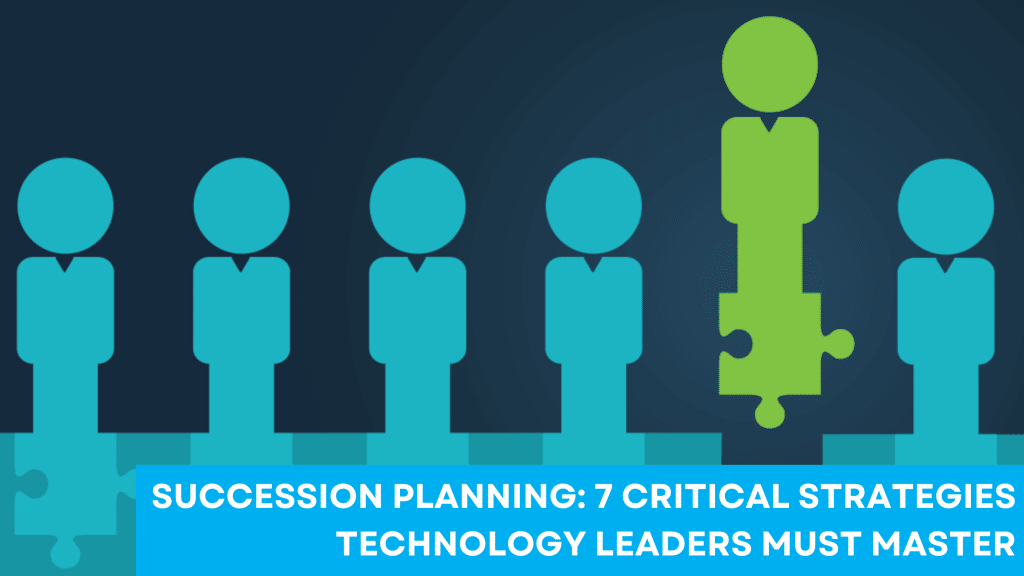Key Takeaways
• Technology sector leadership turnover reached record highs in 2024, with CEO departures increasing 90% year-over-year as AI transformation accelerates
• Internal succession planning delivers superior results, with 84% of successful tech CEO appointments coming from within organizations
• Chief Operating Officers emerge as the primary leadership pipeline, representing 21% of all new CEO appointments across industries
• Emergency succession planning remains critically underdeveloped, with only 37% of companies maintaining formal contingency plans
• Leadership development investments show poor ROI, despite $370 billion in annual spending, with 5 out of 6 HR managers reporting dissatisfaction with results
• First-time executives dominate new appointments, as 85% of incoming CEOs take on the role for the first time, requiring enhanced development programs
The technology sector is experiencing unprecedented leadership upheaval. In 2024, tech CEO turnover skyrocketed by 90% compared to the previous year, with a record 40 technology executives departing their roles. As artificial intelligence reshapes business models and investor activism intensifies, technology leaders face mounting pressure to deliver results while navigating rapid organizational transformation.
This leadership crisis extends far beyond the C-suite. Research reveals that only 35% of organizations maintain formalized succession planning processes for critical roles, while 74% of leaders report feeling unprepared for their responsibilities. For technology companies operating in an environment where innovation cycles compress and market dynamics shift overnight, the absence of robust succession planning represents an existential threat to organizational continuity and competitive advantage.
Why Succession Planning is Critical for Tech Companies
Technology organizations operate within a unique ecosystem that amplifies the consequences of leadership gaps. Unlike traditional industries where operational continuity can sustain short-term leadership vacancies, technology companies depend on visionary leadership to navigate rapid market evolution, technological disruption, and intense competitive pressures.
The financial implications of inadequate succession planning in the technology sector are staggering. The Society of Human Resources Management reports that replacing a single executive costs approximately $4,000 in direct expenses, with additional hidden costs including 45-70 days to identify suitable candidates and up to 18 months for new leaders to achieve full productivity. For technology companies where leadership decisions directly impact product development cycles, market positioning, and investor confidence, these disruptions can prove catastrophic.
The technology sector’s succession planning challenges are compounded by the industry’s rapid evolution. Traditional leadership competencies that served executives well in previous decades may prove inadequate for navigating artificial intelligence integration, cybersecurity threats, and evolving regulatory landscapes. Research indicates that 60% of executives fail within their first 18 months in new roles, a statistic that becomes particularly concerning when considering the accelerated pace of change in technology markets.
Furthermore, the technology industry’s talent pool faces unique constraints. The specialized knowledge required for technology leadership roles limits the available candidate pool, while the industry’s competitive compensation structures create intense talent competition. Organizations that fail to develop internal succession pipelines often find themselves competing for a limited pool of external candidates, driving up recruitment costs and extending vacancy periods.
The demographic shift occurring across the technology workforce adds another layer of complexity to succession planning challenges. In 2025, a record 4.2 million Americans will reach retirement age, creating an unprecedented wave of departures from senior leadership positions. Technology companies that have relied on experienced leaders to guide them through previous market transitions must now prepare for a significant knowledge transfer challenge.
Current State of Succession Planning in Technology
The technology sector’s approach to succession planning reveals a troubling disconnect between the industry’s innovation capabilities and its leadership development practices. Despite being at the forefront of organizational transformation and digital advancement, technology companies lag significantly behind other industries in implementing comprehensive succession planning frameworks.
Recent data from Russell Reynolds Associates demonstrates the severity of this challenge. In 2024, the technology sector experienced the highest CEO turnover rate globally, with 40 executives departing their roles—a 90% increase from the previous year. This unprecedented turnover rate reflects the intense pressures facing technology leaders as they navigate artificial intelligence integration, evolving business models, and heightened investor expectations.
The composition of new technology leadership appointments reveals both promising trends and concerning gaps in succession planning effectiveness. While 84% of incoming technology CEOs were promoted from within their organizations—the highest internal promotion rate across all industries—only 8% of these leaders had previous CEO experience. This statistic suggests that while technology companies are successfully identifying internal talent, they may be inadequately preparing these individuals for executive responsibilities.
| Succession Planning Metric | Technology Sector | All Industries Average |
|---|---|---|
| Internal CEO Appointments | 84% | 73% |
| First-time CEOs | 92% | 85% |
| Planned Succession Rate | 22% | 22% |
| Average CEO Tenure | <5 years | <5 years |
| Emergency Plan Coverage | 37% | 37% |
The technology sector’s succession planning challenges extend beyond executive leadership to encompass critical technical and operational roles. The rapid evolution of technology skills creates a continuous challenge for organizations attempting to identify and develop future leaders. Traditional succession planning models that focus on leadership competencies and management experience may prove insufficient for technology roles that require deep technical expertise combined with strategic vision.
Artificial intelligence and machine learning capabilities are fundamentally reshaping the skills required for technology leadership. Leaders must now possess not only traditional business acumen but also the technical literacy necessary to guide AI implementation, understand algorithmic decision-making, and navigate the ethical implications of automated systems. This evolution in required competencies has outpaced many organizations’ succession planning frameworks, creating gaps between current leadership capabilities and future organizational needs.
The technology sector’s global nature adds additional complexity to succession planning initiatives. Technology companies often operate across multiple jurisdictions with varying regulatory requirements, cultural expectations, and talent markets. Succession planning frameworks must account for these geographic considerations while maintaining consistency in leadership development standards and organizational culture.
Essential Succession Planning Strategies for Tech Leaders
Technology leaders must implement comprehensive succession planning strategies that address the unique challenges and opportunities within their industry. These strategies should encompass both immediate succession needs and long-term leadership development objectives while remaining flexible enough to adapt to rapid technological and market changes.
Strategy 1: Implement Skills-Based Succession Mapping
Traditional succession planning models that focus primarily on hierarchical advancement prove inadequate for technology organizations where technical expertise and innovation capabilities are paramount. Technology leaders should develop skills-based succession mapping that identifies critical competencies required for each role and assesses current talent against these requirements.
This approach involves creating detailed competency profiles for key positions that encompass both technical skills and leadership capabilities. For example, a Chief Technology Officer succession plan should evaluate candidates’ expertise in emerging technologies, their ability to translate technical concepts for business stakeholders, and their track record of leading technical teams through complex projects.
Strategy 2: Establish Cross-Functional Leadership Development Programs
The interconnected nature of technology operations requires leaders who understand multiple functional areas and can collaborate effectively across organizational boundaries. Technology companies should implement cross-functional development programs that expose high-potential employees to various aspects of the business, from product development and engineering to sales and customer success.
These programs should include rotational assignments, mentorship opportunities, and project-based learning experiences that allow emerging leaders to develop a comprehensive business understanding while maintaining their technical expertise. The goal is to create leaders who can bridge the gap between technical innovation and business strategy.
Strategy 3: Leverage Data Analytics for Succession Planning
Technology companies possess sophisticated data analytics capabilities that can be applied to succession planning initiatives. Leaders should implement data-driven approaches to identify high-potential employees, predict succession needs, and measure the effectiveness of leadership development programs.
This strategy involves analyzing performance data, engagement metrics, and career progression patterns to identify individuals with leadership potential. Predictive analytics can help organizations anticipate succession needs based on factors such as retirement eligibility, performance trends, and market conditions.
Strategy 4: Create Technical Leadership Pathways
The technology sector requires leaders who maintain deep technical expertise while developing management capabilities. Organizations should establish dual-track career progression models that allow technical experts to advance into leadership roles without abandoning their technical focus.
These pathways should include technical leadership roles such as Principal Engineer, Distinguished Architect, or Technical Fellow positions that provide leadership opportunities while maintaining technical engagement. This approach helps retain technical talent while developing the next generation of technology leaders.
| Leadership Development Strategy | Implementation Timeline | Success Metrics |
|---|---|---|
| Skills-Based Succession Mapping | 3-6 months | Competency gap analysis completion |
| Cross-Functional Programs | 6-12 months | Program participation rates |
| Data Analytics Integration | 3-9 months | Predictive accuracy improvement |
| Technical Leadership Pathways | 6-18 months | Technical leader retention rates |
Strategy 5: Establish Emergency Succession Protocols
Given the technology sector’s high leadership turnover rates, organizations must maintain robust emergency succession protocols that can be activated immediately when unexpected departures occur. These protocols should identify interim leadership candidates, define decision-making authorities, and establish communication plans for stakeholders.
Emergency succession planning should include detailed documentation of critical responsibilities, key relationships, and ongoing projects for each leadership role. This documentation ensures continuity of operations while permanent succession plans are implemented.
Strategy 6: Integrate Succession Planning with Strategic Planning
Technology companies operate in rapidly evolving markets where strategic priorities can shift quickly. Succession planning initiatives should be closely integrated with strategic planning processes to ensure that leadership development aligns with future organizational needs.
This integration involves regularly reviewing succession plans in the context of strategic objectives, market conditions, and technological trends. Organizations should assess whether their current leadership pipeline possesses the capabilities required to execute future strategic initiatives.
Strategy 7: Develop External Partnership Networks
While internal succession planning should be the primary focus, technology companies should also cultivate external networks that can provide leadership candidates when internal options are insufficient. These networks should include industry associations, academic institutions, and professional development organizations.
External partnerships can also provide benchmarking opportunities, best practice sharing, and access to leadership development resources that may not be available internally. However, external recruitment should complement rather than replace internal succession planning efforts.

Implementation Framework and Best Practices
Successful succession planning implementation requires a structured framework that addresses both immediate needs and long-term organizational development objectives. Technology leaders should adopt a phased approach that builds momentum while delivering measurable results throughout the implementation process.
Phase 1: Assessment and Foundation Building (Months 1-3)
The initial phase focuses on establishing the foundation for comprehensive succession planning. Organizations should begin by conducting thorough assessments of current leadership capabilities, identifying critical roles, and evaluating existing succession planning processes.
This assessment should include stakeholder interviews, competency evaluations, and gap analyses that provide a clear understanding of current state capabilities and future requirements. Technology leaders should also establish governance structures, define roles and responsibilities, and secure necessary resources for succession planning initiatives.
Phase 2: Framework Development and Pilot Programs (Months 4-9)
The second phase involves developing comprehensive succession planning frameworks and implementing pilot programs to test and refine approaches. Organizations should create detailed succession plans for critical roles, establish leadership development programs, and implement measurement systems to track progress.
Pilot programs should focus on high-impact areas where succession planning can deliver immediate value while providing learning opportunities for broader implementation. These programs should include feedback mechanisms that allow for continuous improvement and adaptation based on initial results.
Phase 3: Full Implementation and Integration (Months 10-18)
The final phase encompasses full-scale implementation across the organization and integration with existing human resources and strategic planning processes. Organizations should expand successful pilot programs, implement comprehensive leadership development initiatives, and establish ongoing monitoring and evaluation systems.
This phase should also include change management activities that ensure organizational adoption and sustainability of succession planning practices. Technology leaders should communicate the value of succession planning, provide training for managers and HR professionals, and establish accountability mechanisms for succession planning outcomes.
Best Practices for Technology Succession Planning:
- Maintain Technical Relevance: Ensure succession planning frameworks account for rapidly evolving technical requirements and emerging technology trends
- Emphasize Cultural Fit: Prioritize candidates who demonstrate alignment with organizational culture and values, particularly important in technology companies with strong cultural identities
- Provide Stretch Assignments: Create opportunities for high-potential employees to take on challenging projects that develop leadership capabilities while contributing to business objectives
- Establish Mentorship Programs: Pair emerging leaders with experienced executives who can provide guidance, support, and knowledge transfer
- Regular Plan Updates: Review and update succession plans quarterly to reflect changing business conditions, organizational priorities, and individual development progress
Measuring Success and Common Pitfalls
Effective succession planning requires robust measurement systems that track both process effectiveness and business outcomes. Technology leaders should establish comprehensive metrics that evaluate the success of succession planning initiatives while identifying areas for improvement and optimization.
Key Performance Indicators for Succession Planning:
- Internal Fill Rate: Percentage of leadership positions filled by internal candidates
- Time to Fill: Average duration required to fill vacant leadership positions
- Leadership Readiness: Percentage of critical roles with identified, qualified successors
- Development Program Effectiveness: Promotion rates and performance outcomes for program participants
- Retention Rates: Percentage of high-potential employees retained over specified time periods
- Business Continuity: Operational performance during leadership transitions
Technology companies should track these metrics consistently and analyze trends over time to identify patterns and opportunities for improvement. Regular reporting should be provided to executive leadership and board members to ensure accountability and continued support for succession planning initiatives.
Common Pitfalls in Technology Succession Planning:
Overemphasis on Technical Skills: While technical expertise is crucial in technology organizations, succession planning should not neglect leadership capabilities, emotional intelligence, and strategic thinking skills. The most successful technology leaders combine technical competence with strong leadership abilities.
Inadequate Diversity Considerations: Technology companies often struggle with diversity in leadership positions. Succession planning should actively address diversity objectives by identifying and developing leaders from underrepresented groups while ensuring equitable access to development opportunities.
Insufficient External Perspective: Organizations that focus exclusively on internal succession may develop insular thinking and miss opportunities for fresh perspectives and innovative approaches. Succession planning should balance internal development with selective external recruitment.
Neglecting Soft Skills Development: The technology sector’s focus on technical capabilities can lead to insufficient attention to communication, collaboration, and change management skills that are essential for effective leadership.
| Success Factor | Measurement Approach | Target Benchmark |
|---|---|---|
| Internal Fill Rate | Quarterly tracking | >70% for critical roles |
| Time to Fill | Average days vacant | <60 days |
| Leadership Readiness | Succession depth analysis | 2+ qualified candidates per role |
| Program Effectiveness | Promotion tracking | >50% promotion rate within 3 years |
Risk Mitigation Strategies:
Technology leaders should implement proactive risk mitigation strategies that address potential succession planning failures. These strategies should include scenario planning for various departure situations, cross-training initiatives that reduce single points of failure, and regular succession plan testing through simulated scenarios.
Organizations should also maintain updated documentation of critical processes, relationships, and institutional knowledge to ensure continuity during leadership transitions. This documentation should be regularly reviewed and updated to reflect changing business conditions and organizational priorities.
Conclusion and Next Steps
The technology sector’s unprecedented leadership turnover rates and evolving business landscape demand sophisticated succession planning approaches that go beyond traditional models. Organizations that implement comprehensive succession planning strategies will gain significant competitive advantages through improved leadership continuity, enhanced organizational resilience, and accelerated talent development.
Technology leaders must recognize that succession planning is not merely a human resources function but a strategic imperative that directly impacts organizational performance, innovation capabilities, and long-term sustainability. The integration of succession planning with strategic planning, the emphasis on skills-based development, and the application of data analytics represent essential components of modern succession planning frameworks.
The path forward requires immediate action and sustained commitment. Technology leaders should begin by assessing their current succession planning capabilities, identifying critical gaps, and implementing pilot programs that demonstrate value while building organizational support for comprehensive initiatives.
As the technology sector continues to evolve and face new challenges, organizations with robust succession planning capabilities will be better positioned to navigate uncertainty, capitalize on opportunities, and maintain competitive advantages. The investment in succession planning today will determine organizational success in the rapidly changing technology landscape of tomorrow.
Immediate Action Items for Technology Leaders:
- Conduct a comprehensive assessment of current succession planning capabilities
- Identify critical roles and potential succession gaps
- Implement skills-based succession mapping for key positions
- Establish cross-functional leadership development programs
- Integrate succession planning with strategic planning processes
- Develop emergency succession protocols for unexpected departures
- Create measurement systems to track succession planning effectiveness
The technology sector’s future depends on leaders who can navigate complexity, drive innovation, and inspire organizational transformation. Through strategic succession planning, technology companies can ensure they have the leadership capabilities necessary to thrive in an increasingly competitive and dynamic marketplace.



